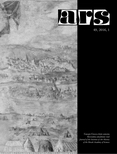
Journal ARS 49 (2016) 1
Margaréta MUSILOVÁ
The Rediscovered Fisherman’s Gate and Gothic Fore-gate in the Possonia Mural Painting in Florence
(Summary)
The Fisherman’s Gate (Rybárska brána) was built in the 14th century as a simple tower-gate, slightly protruding from the city walls. Although it is considered to be the youngest city gate, it was incorporated in the original design of city walls, which is also verified by the medieval town planning. In the first half of the 15th century, as a response to the development of gunnery, a protruding fore-gate with rectangular ground plan was built in front of the gate. The corners of the fore-gate were reinforced by towers with a diameter of 1.8m, crowned with protruded bays and gallery. The plinth was built of carefully shaped blocks, with a line of bevelled blocks on the top. This appearance of the Fisherman’s Gate can be seen in the 1653 historical veduta of the town by Hans Mayer and the unique mural painting POSSONIA at the Palazzo Vecchio in Florence. The mural painting depicting historical Bratislava, which is located in the first courtyard of the palace (the so-called Cortile di Michelozzo), is part of the cycle of views of 14 cities of the Habsburg monarchy, commissioned in 1565 by Cosimo de’Medici for the wedding between his son Francesco and Giovanna d’Austria, daughter of Ferdinand I of Habsburg. The archaeological survey in 2001 revealed surprisingly well preserved remnants of the Gothic fore-gate of Fisherman’s Gate. Uncovered murals represent the most valuable part of the fore-gate, which is a unique example of 15th century Gothic fortification architecture in Slovakia. The construction with a rectangular ground plan had two towers on the corners and a drawbridge in the middle. It was built in the area of a 6m deep moat. In 1529 the main gate was walled up due to the Turkish threat, and the only way to enter the town was through a small gate for the pedestrians and over a wooden bridge of which only the piles have been preserved. In 1756, the Fisherman’s Gate together with the fore-gate were renovated and renamed as the Gate of Empress Maria Theresa. In 1776, at the empress’s command, the gate was torn down. In the context of other remains of city fortification, the uniqueness of the fore-gate consists in the quality of the type of Gothic fortification architecture that has not been applied to any other city gate. This effort is definitely linked with grandiose plans of Sigismund of Luxemburg, Holy Roman Emperor, King of Hungary and Bohemia, to make Bratislava (Possonia) a capital of his empire. High and slender towers considerably differ from images of other city towers and gates. They reveal a strong influence of French fortification architecture. During his journeys across Europe, Sigismund of Luxemburg was mostly inspired by French Gothic art. He invited master stonemasons from southern Germany, Italy and France. Originally they participated in the construction of the Fresh Palace in Buda , and later they moved to Bratislava to work on the Bratislava castle and St. Martin’s Cathedral. France had a strong influence on the international Gothic style in the transalpine area. The fore-gate flanked with two towers was inspired by French Gothic art. Apart from the two aforementioned leaflets depicting the coronation of Maximilian II and the view of Possonia in Florence, this appearance of the fore-gate of Fisherman’s Gate can also be seen in the 1685 copperplate made after W. Dilich. Two semicircular towers are also depicted in Burgstaller’s water regulation plans of 1735. The fore-gate was built in the 40 m wide and 6–7 m deep moat. Among the archaeological discoveries in the moat were unbroken pieces of clay kitchenware, wooden objects, and metal tools in the moat. The archaeologists also uncovered the remains of the wooden bridge, namely 24 well-preserved piles made of pin oak, which, after the main gate had been walled up in 1529 due to the Turkish threat, made accessible the pedestrian gate from the eastern side. After 1735 a channel was built from brick and stone on the eastern side in order to regulate water in the unkempt and partially clogged moat. What makes the discovery of the fore-gate of Fisherman’s Gate so unique is the fact that it is the only city gate in Bratislava with this type of fortification architecture. The fore-gate of the Michael’s Gate, which has been preserved to the present day, is Baroque in style, while the Fisherman’s Gate represents the medieval fortification in the original form. The quality of construction of the southern wall of the fortification and corner towers using massive limestone blocks gives evidence of a precise Gothic fortification construction. The discovery and presentation of the remains of Fisherman’s Gate based on the survey conducted by the Municipal Monument Preservation Institute in Bratislava was granted the “2001 Discovery of the Year” award and the medal Europa Nostra 2002 for the protection of cultural heritage of the European Union. The restoration of the mural painting in Florence was a result of a long-time effort to save the unique artwork, one of the earliest depictions of Bratislava from the second half of the 16th century.